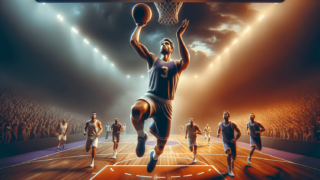
How to Improve Your Basketball Passing Accuracy?
Written by: Basketball Universe
Last updated:

Mastering the art of pinpoint passing is an essential skill for any aspiring basketball player aiming to elevate their game to the next level. In this blog post, we explore effective techniques and tips that will help you transform into a passing maestro. So, whether you’re a seasoned player or a budding enthusiast, buckle up, and join us as we uncover the keys that will unlock your full potential in distributing the ball with precision and flair on the court. It’s time to add some magic to your basketball passing accuracy!
How to Improve Your Basketball Passing Accuracy?
To improve your basketball passing accuracy, focus on perfecting your technique by practicing various types of passes, such as chest passes, bounce passes, and overhead passes. Additionally, strengthen your fingers and wrists to increase control over the ball. Enhance your court vision by observing teammates’ movements and spotting open spaces, and develop your decision-making to know when and where to pass. Participating in team drills and honoring the fundamentals of the game, such as good spacing, timing, and communication, will lead to precision passing and overall improvement of your basketball skills.
The Importance of Passing Accuracy in Basketball
Accurate passing is a critical aspect of basketball, as it not only ensures offensive fluidity but also prevents turnovers and opens up scoring opportunities for your teammates. To become a better basketball player and a valuable asset to your team, you must improve your basketball passing accuracy.
Master the Different Types of Passes
There are several common passes in basketball, and honing your skill in each one will provide you with a versatile and accurate passing repertoire. Make sure to practice the following types of passes frequently:
Chest Pass
As one of the quickest and most fundamental passes in basketball, the chest pass is performed by stepping toward the target while pushing the ball outward from the chest. To improve accuracy, ensure both of your hands are placed on the sides of the ball, applying equal pressure with fingertips, and using a full follow-through on release.
Bounce Pass
The bounce pass can be an effective way to get the ball past defenders, particularly in congested spaces. To execute this, step towards the target while aiming to bounce the ball nearly two-thirds of the distance. While practicing, concentrate on bouncing the ball with enough force to reach the target while maintaining control and finesse.
Overhead Pass
An overhead pass involves holding the ball above your head with both hands on the sides and releasing it in a quick, snapping motion. This type of pass is excellent for making long-distance passes, breaking presses, or for feeding a teammate in the post. Practice your release technique and wrist strength to increase accuracy in this pass.
Strengthen Your Fingers and Wrists
Strong fingers and wrists greatly contribute to improved basketball passing accuracy, as they provide better control and grip on the ball. Incorporate hand and wrist workouts into your training routine to develop strength and stability in this area, such as:
- Fingertip push-ups
- Hand squeezes
- Wrist curls
- Ball dribbling exercises
Develop Your Court Vision and Decision-Making
Strong court vision and decision-making are vital for accurate passing in basketball. When you can see and interpret the movement of other players on the court, you can make better decisions about when and where to pass the ball. To improve upon these skills:
Study the Game
Watch professional basketball games, study top-notch players, and understand the offensive and defensive strategies employed by well-coached basketball teams. Familiarize yourself with effective team spacing, player movements, and successful plays.
Improve Awareness in Drills and Scrimmages
During team drills and scrimmages, work on being constantly aware of your teammates and opponents. Recognize where your teammates should be on the court and attempt to anticipate their movements based on your understanding of various offensive formations and plays.
Learn to Read the Defense
Being able to read your opponents’ defensive tactics can significantly contribute to your basketball passing accuracy. By understanding their positioning and tendencies, you’ll have a better idea of how and when to make an effective pass. To enhance this skill, watch film on opposing teams, practice making quick reads in game-like situations, and learn to identify common defensive patterns and strategies.
Practice Your Passing in Pressure Situations
Making accurate passes under pressure is an essential skill for any basketball player. Improve your passing accuracy under duress with the following tips:
Simulate Game-like Conditions
During practice sessions, create drills that simulate defensive pressure, such as being double-teamed or trapped. This will help you develop the ability to make precise passes as you would in live games.
Rehearse a Variety of Passes
Repeating various passes in pressure situations will help you understand how each pass performs under defensive pressure. Experiment with chest passes, bounce passes, and overhead passes to build confidence in your ability to accurately distribute the ball in contested situations.
Emphasize Team Drills and Fundamentals
Practicing within a team environment will allow you to develop chemistry with your teammates, reinforcing the importance of spacing, timing, and communication. Be proactive when performing team drills:
Work on Spacing
Good spacing is essential to maximize passing lanes and create opportunities for efficient ball movement. It offers a more significant margin for error when passing to teammates.
Focus on Timing
Timing is crucial when it comes to accurately passing the ball, as it can be the difference between a completed pass or a turnover. Anticipate your teammates’ movements and adjust your passing speed based on their position and the situation on the court.
Communicate on the Court
Effective communication with your teammates can dramatically improve your passing accuracy. Develop verbal and non-verbal cues (such as hand signals) to communicate with your teammates, ensuring smooth execution and precision.
Drills to Improve Your Basketball Passing Accuracy
Implementing drills specifically designed to target passing accuracy is an essential aspect of improving your skills. Here are a few suggested drills:
Partner Passing Drills
Practice different types of passes with a partner, varying the distance, the angle, and incorporating defensive pressure, all while concentrating on accuracy and control throughout.
Wall Passing Drills
If you don’t have a partner, use a wall to practice your passes. Mark a target on the wall and aim to hit it consistently with various types of passes, focusing on power and accuracy.
Three-Man Weave Drill
This classic basketball drill involves fast-paced passing between three players while running down the court. The objective is passing the ball while maintaining accurate passes, proper spacing, and precise timing. This drill helps improve both offensive rhythm and passing accuracy.
Consistency Is Key to Improve Your Basketball Passing Accuracy
As with any skill, consistency is crucial when it comes to improving your basketball passing accuracy. Dedicate time to practice each aspect of passing, from technique to decision-making, and make it a part of your regular basketball training routine. Remember – the more you practice, the more accurate your passes will become, leading to better overall performance on the court.
Additional Elements That Affect Passing Accuracy
Improving your basketball passing accuracy is not limited to mastery of techniques, strength training, or good decision-making. There are other vital elements that contribute to your overall success in distributing the ball efficiently.
Body Control and Balance
Maintaining good body control and balance while passing goes a long way in ensuring accuracy under various challenging conditions, such as playing under pressure or making off-balance passes. Here are a few tips to help you develop better body control and balance:
- Perform agility, speed, and balance drills to help improve your overall athleticism.
- Focus on your core strength, as it plays a significant role in stabilizing your body when you pass the ball.
- Engage in yoga, tai chi, or other mind-body disciplines to enhance overall body control, coordination, and awareness.
Passing with Both Hands Equally
Being able to pass accurately with both your dominant and non-dominant hand is essential for an effective passer. Ambidexterity ensures you are well-prepared for any situation on the court. To develop this skill:
- Make a conscious effort to use your non-dominant hand during passing drills.
- Practice making one-handed passes and catches with both hands to train your weaker hand.
- Perform ball handling and dribbling exercises regularly with your non-dominant hand to improve overall dexterity.
Understanding Individual Teammates’ Preferences
Just as players have different strengths and weaknesses, each teammate has their own preferences when it comes to receiving passes. To enhance passing accuracy, consider these points:
- Take note of where your teammates prefer to receive the ball to optimize their chances of executing a successful play.
- Adjust your passes based on individual teammate dynamics, such as a taller player jumping higher or a quicker player needing faster and harder passes.
- Communicate with your teammates and solicit feedback on your passing during practice sessions to improve your understanding of their preferences.
Incorporating Advanced Passes and Deception
As your basketball passing accuracy and skills improve, you can begin experimenting with more advanced passes and incorporate deception techniques to make it even more challenging for defenders. Here are some examples:
No-Look Pass
This pass relies on strong peripheral vision, quick decision-making, and excellent communication. Look in one direction while simultaneously delivering the ball in another to throw off defenders and catch them off-guard.
Behind-the-Back Pass
This advanced passing technique requires confidence, deception, and practice. Holding the ball with one hand, swing it behind your back, and use your opposite hand to guide the ball towards your intended target.
Keep Learning and Growing
Perfecting your basketball passing accuracy is a long-term process with constant room for growth and improvement. Continue refining your passing techniques, incorporate new drills, learn from peers and coaches, and persistently analyze your performance during games and practice sessions. As you implement these tips and suggestions, you’ll find yourself becoming an increasingly accurate and efficient basketball passer, significantly increasing your value to any team.
FAQ Section: Improving Your Basketball Passing Accuracy
To further assist you in enhancing your passing skills, we have compiled a list of frequently asked questions and answers related to basketball passing accuracy. Discover more tips, tricks, and valuable insights that will empower you to take your game to the next level!
1. How much time should I dedicate to improving my passing accuracy?
The amount of time you dedicate to improving your passing accuracy depends on your current skill level, goals, and overall commitment to the game. As a general rule, it is essential to practice regularly, integrating passing drills and exercises into several training sessions per week for continuous improvement.
2. Are there any specific exercises I can do to improve my peripheral vision for passing?
Yes, there are exercises designed to enhance peripheral vision, such as the “peripheral card drill.” In this exercise, hold a playing card in your peripheral vision while focusing on a central point. Identify the numbers or suits on the card while maintaining your gaze on the center point. You can also use a “tachistoscope” app to improve overall dynamic visual acuity and strengthen peripheral vision.
3. What is the role of footwork in passing accuracy?
Proper footwork is crucial for passing accuracy as it provides balance, control, and power in your passes. Ensure that you are stepping towards your target, pivoting effectively when needed, and shifting your weight correctly during various types of passes. Developing solid footwork will significantly improve your passing accuracy, along with other aspects of your basketball game.
4. How can I improve my accuracy when passing the ball off the dribble?
To improve your passing accuracy off the dribble, focus on mastering the following aspects: control of the ball throughout the dribbling motion, anticipating teammate movement and positioning, and identifying defensive tactics. Additionally, practice quick stops and change-of-pace dribbling to create more passing opportunities and execute passes effectively.
5. How can I build chemistry with my teammates to improve my passing accuracy?
Building chemistry with your teammates involves consistent communication, understanding individual preferences, and actively participating in team drills and scrimmages. By getting to know your teammates on and off the court, you will gain valuable insight into their tendencies, making it easier to anticipate their movements and adjust your passes accordingly.
6. How can I minimize turnovers when trying to improve passing accuracy?
Minimize turnovers by working on your decision-making, court vision, timings, and reacting to both defensive and offensive situations. Develop a strong understanding of offensive strategies and make smart, calculated decisions based on factors such as defensive positioning, passing angles, and teammate location. Avoid risky passes when not necessary, and opt for safer and more accurate options.
7. Are there any mental exercises I can do to improve my passing accuracy?
Mental exercises, such as visualization and meditation, can be beneficial in improving your passing accuracy. Visualization can help you mentally prepare for game situations, enhance court awareness, and reinforce proper passing techniques. Meditation can help with focus, concentration, and managing in-game stress, further contributing to accurate passing under various conditions.
8. How can I improve my passing accuracy during fast breaks or transition situations?
Improving passing accuracy during fast breaks or transition situations involves developing good court vision, quick decision-making, and precise passing execution. Practice identifying open teammates, reacting to defensive constraints, and delivering accurate passes at different paces and angles. Drills like the three-man weave or the five-man fast break can help you work on these skills in game-like situations.
9. Can taller players improve their passing accuracy in crowded situations, such as in the paint?
Yes, taller players can improve their passing accuracy in crowded situations by developing a strong sense of spatial awareness, mastering various pass types, and utilizing their height advantage to see over defenders. Focus on mastering bounce passes, quick interior passes, and deceptive overhead passes, and utilize your height for passing over the top of shorter defenders.
10. What is the best way to track my improvement in passing accuracy?
To track improvement in passing accuracy, consider setting specific goals and measuring your progress against those benchmarks. Analyze your performance during practice sessions, scrimmages, or actual games to identify areas for improvement. Emphasize quantitative measurements, such as practice completion rates or game stats (assists-to-turnovers), as well as qualitative feedback from coaches and teammates.
Featured Posts
- No pillar pages found.





